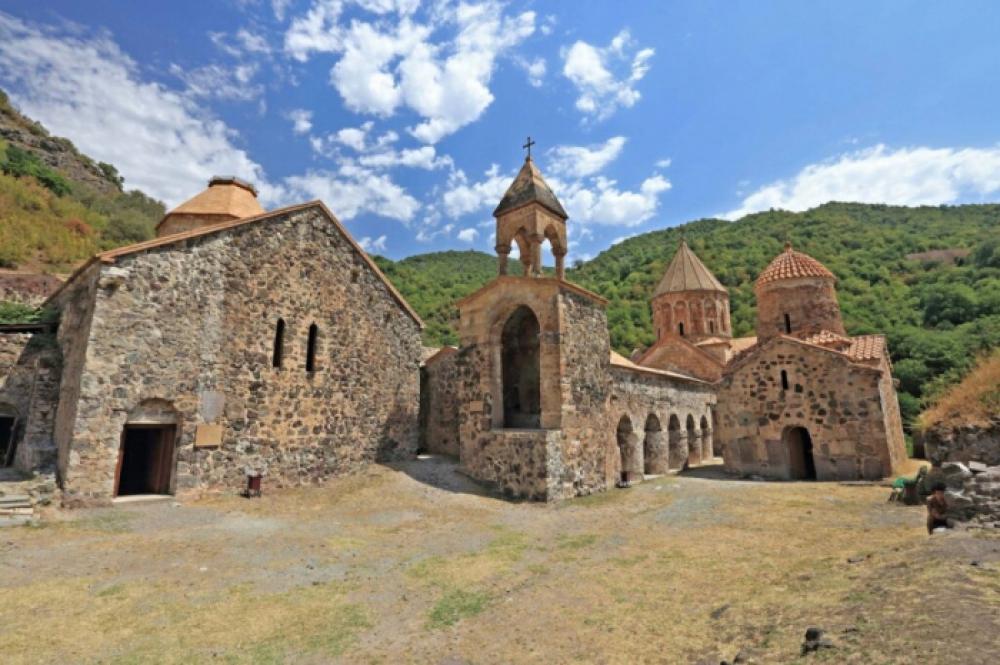Albanian-Udi community: Armenia changed architecture of sanctuaries

By Sabina Mammadli
Armenia either has changed the architecture of the Albanian sanctuaries to make them Gregorian or has devastated those shrines in which architecture could not be changed.
The remarks were made in a statement published by the Albanian-Udi Christian community of Azerbaijan.
The community stressed that making the Albanian heritage, including the Albanian sanctuaries, which are hundreds and even thousands of years old, belong to the Gregorian Church has been a government policy of Armenia over the past hundred years.
“As a result of this, not a single Albanian shrine has been preserved in the contemporary territory of Armenia and the occupied lands of Azerbaijan,” the statement reads.
The statement noted that following different pressure and influence, the Albanian Apostolic Church was abolished in 1836, while the Armenian Gregorian Church attempted to own some of its material and moral heritage.
“As a result, a great deal of the historic Albanian sanctuaries in Azerbaijan, especially in Karabakh, has been made Gregorian and the archives and documents have also been falsified together with their historical monuments.,” the statement reads.
The community stressed that after Azerbaijan restored its independence, a historical opportunity emerged to restore the status of the Albanian Apostolic Church and eliminate the injustice the community had faced.
The statement also recalled that the history of structuring Christianity as an official religion in the Caucasus starts with the Albanian Church, the ancientness of which is proved not just by historic facts, but also by the ancient Albanian sanctuaries which have survived to the present day.
“Ancient sources prove that the Albanian Church, which has left ineffaceable traces in the religious and cultural life of not only Azerbaijan but also the entire Caucasus, is one of the most ancient churches in the world and has an apostolic origin,” the statement reads.
It was noted that the Albanian-Udi Christian community was set up and received official registration in 2003 at the initiative of the intellectuals of Udis. The registration of the religious community was the first step towards the revival of the Albanian Apostolic Autocephalous Church.
“The Apostol Elisha Church, which is considered to be “the mother of the churches” in the Caucasus, in the village of Kish in Shaki district was renovated with the support of the Azerbaijani government and the Albanian-Udi Church called Chotari in the settlement of Nij, which Udis densely populate in Gabala district was officially opened in 2006,” the statement reads.
The community stressed that the revival of the Albanian-Udi Christian community and the elimination of the historical injustice with the restoration of the Albanian monuments are important not only for Azerbaijan but also for the entire Christian world in terms of preserving the environment of tolerance in the country.
"We, the Udis, who are the moral successors of the Albanian Apostolic Church, believe that other Albanian sanctuaries in our territories liberated from occupation will also be restored to a high level like the Albanian shrines in Qabala and Oguz region," the statement added.
The community also emphasized that the tolerance of the Azerbaijani people and the care and support of the Azerbaijani government to representatives of all the religions make them believe that those who belong to the Armenian Gregorian Church will also be treated with humanism.
They bring as an example of this, the Sacred Gregory Armenian church situated in the center of Baku, which the Azerbaijani government has preserved and restored.
"Despite the facts that the Armenian Gregorian Church has inserted influence and pressure and has dealt a heavy blow to the Albanian heritage through appropriation and falsification over centuries, we would like to say that we are ready for cooperation with the Armenian Gregorian Church and co-existence in the territories liberated from occupation for the sake of peace and humanity,” the statement says.
Additionally, the community stressed that despite the mine threats and a very bad condition of roads, they have visited the historical Albanian shrines in the liberated territories, including the Aghoghlan monastery in the Lachin region, the Khudavang monastery in the Kalbajar region, as well as Albanian sanctuaries in Hadrut settlement and Tugh village.
“We highly appreciate and support the consecutive actions to preserve and restore the historical and religious monuments, including the sanctuaries of the heritage of Albanian Christians, in the territories liberated from occupation over the past year and express our confidence that this process will be finalized as soon as possible thanks to the will and perseverance of the government of Azerbaijan,” the statement added.
--
Follow us on Twitter @AzerNewsAz
Here we are to serve you with news right now. It does not cost much, but worth your attention.
Choose to support open, independent, quality journalism and subscribe on a monthly basis.
By subscribing to our online newspaper, you can have full digital access to all news, analysis, and much more.
You can also follow AzerNEWS on Twitter @AzerNewsAz or Facebook @AzerNewsNewspaper
Thank you!
